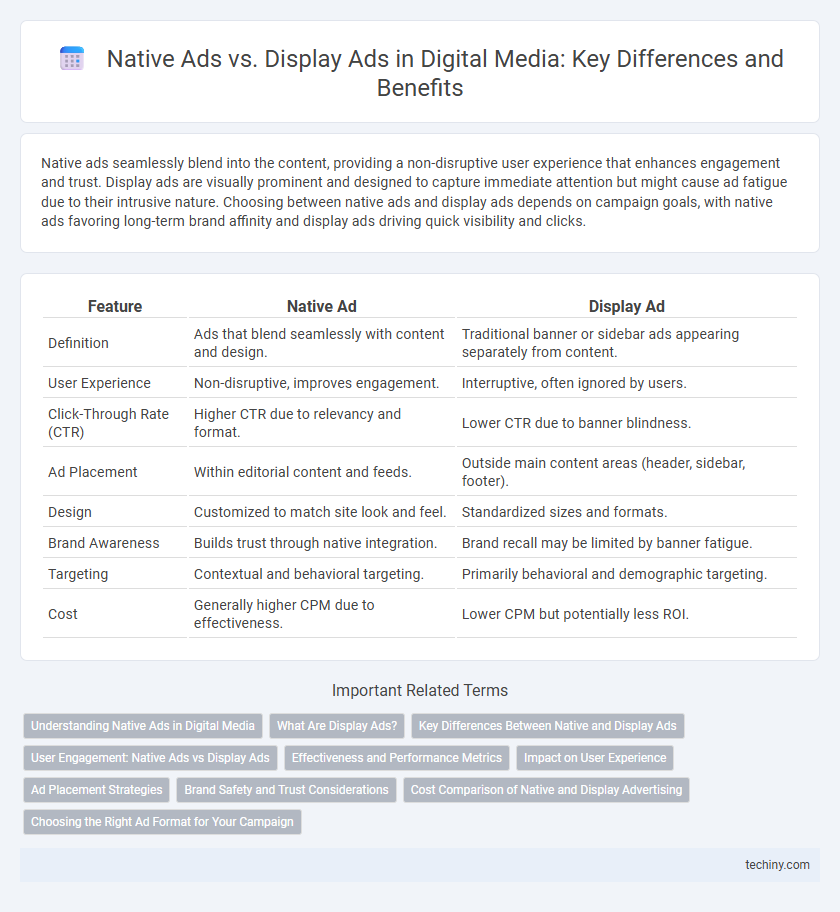Native ads seamlessly blend into the content, providing a non-disruptive user experience that enhances engagement and trust. Display ads are visually prominent and designed to capture immediate attention but might cause ad fatigue due to their intrusive nature. Choosing between native ads and display ads depends on campaign goals, with native ads favoring long-term brand affinity and display ads driving quick visibility and clicks.
Table of Comparison
| Feature | Native Ad | Display Ad |
|---|---|---|
| Definition | Ads that blend seamlessly with content and design. | Traditional banner or sidebar ads appearing separately from content. |
| User Experience | Non-disruptive, improves engagement. | Interruptive, often ignored by users. |
| Click-Through Rate (CTR) | Higher CTR due to relevancy and format. | Lower CTR due to banner blindness. |
| Ad Placement | Within editorial content and feeds. | Outside main content areas (header, sidebar, footer). |
| Design | Customized to match site look and feel. | Standardized sizes and formats. |
| Brand Awareness | Builds trust through native integration. | Brand recall may be limited by banner fatigue. |
| Targeting | Contextual and behavioral targeting. | Primarily behavioral and demographic targeting. |
| Cost | Generally higher CPM due to effectiveness. | Lower CPM but potentially less ROI. |
Understanding Native Ads in Digital Media
Native ads seamlessly integrate with digital media content, matching the form and function of the platform to enhance user experience and engagement. Unlike traditional display ads, they avoid disruption by blending naturally into the content stream, increasing the likelihood of user interaction and brand recall. Platforms like Facebook, Instagram, and native ad networks utilize these ads to deliver personalized, contextually relevant marketing that drives higher click-through rates and conversion.
What Are Display Ads?
Display ads are visual advertisements that appear on websites, social media platforms, and apps, typically in the form of banners, images, or videos designed to capture user attention. These ads use targeting techniques such as cookies and user behavior analysis to reach specific audiences and drive traffic or conversions. Display ads differ from native ads by being more overt and distinct from the surrounding content, often appearing as standalone elements on digital media pages.
Key Differences Between Native and Display Ads
Native ads seamlessly blend with the content and design of the platform, providing a less intrusive user experience, while display ads are typically more visually distinct with banners or pop-ups designed to capture immediate attention. Native ads drive higher engagement by matching the editorial style and user intent, whereas display ads rely on bold graphics and placements to achieve visibility. The performance metrics also differ; native ads often result in better click-through and conversion rates due to their integrated approach compared to the more disruptive nature of display ads.
User Engagement: Native Ads vs Display Ads
Native ads generate higher user engagement by blending seamlessly with content, leading to increased click-through rates and longer view times compared to display ads. Display ads, often perceived as intrusive, tend to have higher bounce rates and lower interaction levels. Data from eMarketer shows native ads achieve up to 53% more engagement than traditional display advertising.
Effectiveness and Performance Metrics
Native ads seamlessly integrate with website content, resulting in higher user engagement rates and click-through rates (CTR) compared to traditional display ads, which often suffer from ad blindness. Performance metrics such as conversion rate and time spent on page consistently favor native advertising, highlighting its effectiveness in delivering relevant, non-disruptive brand messaging. Display ads excel in brand visibility through widespread reach and impressions but typically yield lower engagement levels, making native ads a superior choice for targeted digital media campaigns.
Impact on User Experience
Native ads seamlessly blend with digital media content, enhancing user engagement by appearing less intrusive and maintaining the platform's visual flow. Display ads often interrupt user experience with flashy graphics or pop-ups, leading to higher bounce rates and ad fatigue. Optimizing digital strategies requires balancing native ad integration to improve user satisfaction and brand recall.
Ad Placement Strategies
Native ads integrate seamlessly within digital media content by matching the style and format of the platform, increasing user engagement through subtle ad placement. Display ads are typically placed in designated areas such as banners or sidebars, designed to capture immediate attention but may face ad blindness from users. Effective ad placement strategies leverage native ads within content feeds for organic interaction, while utilizing display ads in high-visibility zones to boost brand awareness and clicks.
Brand Safety and Trust Considerations
Native ads seamlessly blend with digital content, enhancing brand safety by reducing intrusion and ad-blocking risks, thus fostering higher consumer trust. Display ads, while visually prominent, often face challenges related to ad fraud and placement next to inappropriate content, potentially damaging brand reputation. Effective brand safety measures, such as contextual targeting and third-party verification, are crucial in both formats to maintain trust and protect brand integrity in digital media campaigns.
Cost Comparison of Native and Display Advertising
Native advertising often commands higher CPM rates due to its seamless integration within content, resulting in increased production costs compared to standard display ads. Display advertising typically features lower upfront expenses and reduced CPMs but may yield lower engagement and click-through rates. Advertisers must assess budget allocation carefully, balancing native ad investments against display ad efficiencies to optimize ROI in digital media campaigns.
Choosing the Right Ad Format for Your Campaign
Selecting the right ad format between native ads and display ads depends on campaign goals, target audience, and content integration. Native ads offer seamless user experience by matching the look and feel of the platform, increasing engagement and brand trust. Display ads provide high visibility and quick recognition with bold visuals, ideal for driving immediate clicks and brand awareness in diverse digital media environments.
Native Ad vs Display Ad Infographic

 techiny.com
techiny.com